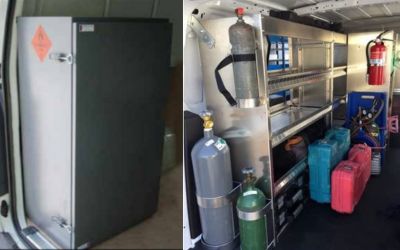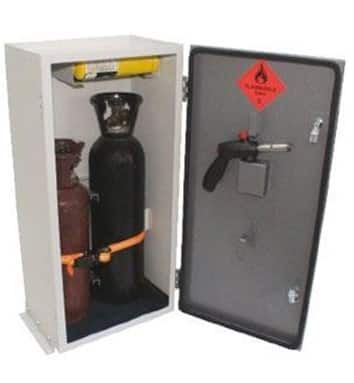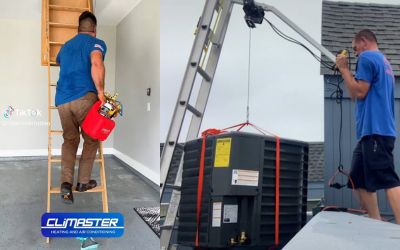
HVAC & refrigeration maintenance work often requires using a range of gas – including refrigerants, oxygen, map-pro and acetylene. These gases are dangerous and can cause fires if not handled correctly. It’s important to know how to handle gas tanks safely, not only on the job – but also when travelling and storing.
In this article, we’ll explore:
- The risks of gas used in HVAC
- Common HVAC Van mistakes
- Guidelines for travelling with gas cylinders
- Transforming your HVAC service van for safe travelling
What are the risks of gas used HVAC?
Map-pro, acetylene and most refrigerants today are flammable. Flammable goods can cause explosions or fires and serious injury if not handled correctly. In addition, acetylene and some refrigerants are highly reactive and can react with certain metals. If acetylene is in contact with water, it will produce ammonia which is a toxic gas.
Some gas leaks can be odorless or difficult to smell, including oxygen and some refrigerants.
- Refrigerants: These are perhaps the most widely used gases in HVAC repairs and maintenance. Common refrigerants include R-410A, R-22, and R-134a, which are used in air conditioning systems and heat pumps to facilitate the heat transfer process. Most of these gases are considered highly flammable.
- Oxygen, Map-Pro and Acetylene: These gases are used with torches for tasks such as brazing and soldering copper pipes in HVAC systems. Map-Pro and acetylene gases are considered highly flammable and oxygen and accelerant gas.
- Nitrogen: Whilst non-flammable and considered safer, this gas can still cause asphyxiation (oxygen deprivation) if leaked in a closed space
Common HVAC van mistakes to AVOID
Unfortunately, compressed gas accidents occur every year. Not only are these accidents usually preventable, but many technicians fail to consider the dangers when storing and handling compressed gas incorrectly. Below are some common mistakes and what you should do to travel safetly.
#1 Storing tanks on an angle
A common mistake with transporting gas cylinders is storing them horizontally or on an angle. Flammable gas tanks such as refrigerants and acetylene must be stored vertically upright.
Most gases (i.e. LPG and acetylene) are stored in a liquid phase in high pressurised cylinders. Some flammable gas tanks contain a pressure relief valve that must be in contact with the gaseous phase to function properly if the cylinder reaches excess pressure, such as if the cylinder is exposed to heat. Storing cylinders upright ensure that the liquid phase remains at the bottom, so that the pressure relief valve can be used in an emergency.
#2 Placing tanks in the tool bin
When travelling with cylinders, you can’t just throw them in your tool compartment bin or shelf. It’s important that tanks are secured and do not wobble around when travelling – to reduce the risk of tanks falling or colliding.
Make sure to create a secure mount or compartment dedicated to storing cylinders. Webbing straps can also be used for extra security.
#3 No ventilation
Travelling with cylinders in a closed vehicle (such as a van) is considered very dangerous. In the event of a leak – even minor – gas can build up in the vehicle and result in a fire or explosion.
Always carry cylinders in an open vehicle. If you’re transporting cylinders in a closed vehicle such as a van, it is recommended to have a purpose-built cabinet with adequate ventilation for leaking gas to flow outside the vehicle.
In addition, you can leave your windows open to keep the vehicle ventilated.
It’s important to know that some gases including refrigerants and Map-Pro are heavier than air and can therefore pool at the bottom of your vehicle.
#4 Keeping regulators on the tanks
Whether you’re using oxy-acetylene or oxy-map setups, always remove the regulators and tightly fit the tanks with safety caps before travelling.
Guidelines for travelling with compressed gas cylinders

When storing or transporting gas cylinders always ensure:
- Valves are tightly closed. For gas bottles without adjustable valves, valve protection caps are placed on and tightly secured.
- Cylinders are secured in an upright position.
- Cylinders are secured and do not hit surrounding tools or cylinders during transportation.
- Cylinders are transported in an open vehicle. If a closed vehicle (i.e. van) must be used – a purpose built sealed compartment or cabinet should be used that provides adequate ventilation of any leaking gas to outside the vehicle.
- Cylinders cannot be struck by other objects (eg loose tools and materials)
- Oxygen cylinders should be placed separately from fuel-gas cylinders with a non-combustible barrier in-between
Please refer to OSHA standards 1926.350 and your local guidelines for more information on transporting, moving and storing compressed gas cylinders.
Transforming your Service Van for Safe Travelling
It’s easy to fall into the habit of chucking your gear and work equipment wherever it fits. It’s important to take the time to dedicate a spot for storing tanks for safety and efficiency. Here are some ideas on how to travel with tanks:
1# Use a Sealed Gas Storage Cabinet
If you are travelling in a close vehicle (such as a van), install a purpose-built gas storage cabinet that provides adequate ventilation of any leaking gas to outside the vehicle.

#2 Use a mount for your tanks
A gas tank mount can be installed inside your van. This option offers quick and easy access. Lighter tanks or disposable tanks can also be mounted above ground level. Some mounts are adjustable to suit various cylinder sizes

#3 Build a gas tank holder
A gas tank holder can be built to fit tanks. This option is ideal for various-sized cylinders as compartments can be customised to suit your cylinder.
#4 Secure cylinders using webbing straps
Cylinders can be restrained vertically using webbing straps. Make sure you use multiple ropes to lock down the cylinders. Do not use flexible or thin tying materials like elastic wraps and ropes.
This option is ideal if you need a quicker solution and can be installed on a ute or pickup truck. Flammable gases such as acetylene MUST be restrained upright. USA Safety provides stands designed for standing larger cylinders upright

Ambro Controls
Ambro Controls offers disposable fuel & refrigerant cylinders that are durable, compact and lightweight, designed to make work easier for trade applications and working in confined spaces. These cylinders also offer a convenient size for travelling. Learn more about our disposable Gas and Refrigerant cylinder options here




